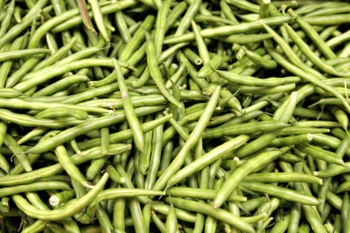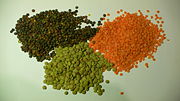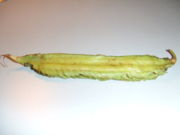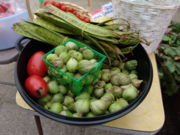Bean
2008/9 Schools Wikipedia Selection. Related subjects: Food; Plants
Bean is a common name for large plant seeds of several genera of the family Fabaceae (formerly Leguminosae) used for human food or animal feed.
Although "beans" usually means the seeds of bean plants, it can also mean (especially in the US) the whole young pods of bean plants, which if picked before the pods ripen and dry, can be tender enough to eat whole, whether cooked or raw. Thus the word "green beans" means "green" in the sense of unripe (many are in fact, not green in colour), as the beans inside the pods of green beans are too small to comprise a significant part of the cooked fruit.
Terminology
The term "bean" originally referred to the seed of the broad bean, but was later expanded to include members of the genus Phaseolus, such as the common bean and the runner bean, and the related genus Vigna. The term is now applied in a general way to many other related plants such as soybeans, peas, lentils, kidney beans, chickpeas (garbanzos), vetches and lupins.
"Bean" can be used as a near-synonym of " pulse", an edible legume, though the term "pulses" is usually reserved for leguminous crops harvested for their dry grain and usually excludes crops mainly used for oil extraction (like soybeans and peanuts) or those used exclusively for sowing purposes (such as clover and alfalfa). Leguminous crops harvested green for food, such as snap peas, snow peas, etc., are classified as vegetable crops.
In English usage, the word "beans" is also sometimes used to mean the seeds or pods of plants that are not in the family Leguminosae, but which bear a superficial resemblance to true beans, for example coffee beans, castor beans and cocoa beans (which resemble bean seeds), and vanilla beans (which resemble the pods).
History
Beans are one of the longest-cultivated plants, broad beans having been grown at least since ancient Egypt, and the common bean for six thousand years in the Americas.
Many modern dry beans come from old-world varieties of broad beans, but most of the kinds commonly eaten fresh come from the Americas, being first seen by Christopher Columbus during his conquest of a region of what may have been the Bahamas, where they were grown in fields.
One especially famous use of beans by pre-Columbian people is the Three Sisters method of companion plant cultivation:
- On the east coast of what would come to be called the United States, some tribes would grow maize (corn), beans, and squash intermingled together, a system which had originated in Mexico. The corn would not be planted in rows as it is today, but in a checkerboard/hex fashion across a field, separate patches of one to four stalks each.
- Beans would be planted around the base of the developing stalks, and would vine their way up as the stalks grew. All American beans at that time were vine plants, "bush beans" having only been bred more recently. The cornstalks would work as a trellis for the beans, and the beans would provide much-needed nitrogen for the corn.
- Squash would then be planted in the spaces between the patches of corn in the field. They would be provided slight shelter from the sun by the corn, and would deter many animals from attacking the corn and beans, because their coarse, hairy vines and broad, stiff leaves are difficult or uncomfortable for animals like deer and raccoons to walk through, crows to land on, et cetera.
Beans were an important alternative source of protein throughout old and new world history, and still are today. There are over 4,000 cultivars of bean on record in the United States, alone.
An interesting modern example of the diversity of bean use is 15 bean soup, which, as the name implies, contains literally fifteen different varieties of bean.
Types of beans
As illustrated by 15 bean soup, there is a great variety of beans types, including:
- Vicia
- Faba or broad bean
- Vigna
- Aconitifolia or Moth bean
- Angularis or azuki bean
- mungo or urad bean
- radiata or mung bean
- umbellatta or rice bean
- unguiculata or cowpea (includes the black-eyed pea, yardlong bean and others)
- Cicer
- arietinum or chickpea (also known as the garbanzo bean)
- Pisum
- sativum or pea
- Lathyrus
- Lathyrus sativus (Indian pea)
- Lathyrus tuberosus (Tuberous pea)
- Lens
- culinaris or lentil
- Lablab
- purpureus or hyacinth bean
- Phaseolus
- acutifolius or tepary bean
- coccineus or runner bean
- lunatus or lima bean
- vulgaris or common bean (includes the pinto bean, kidney bean, caparrones, and many others)
- Glycine
- max or soybean
- Psophocarpus
- tetragonolobus or winged bean
- Cajanus
- cajan or pigeon pea
- Stizolobium
- spp or velvet bean
- Cyamopsis
- tetragonoloba or guar
- Canavalia
- ensiformis or jack bean
- gladiata or sword bean
- Macrotyloma
- M. uniflorum or horse gram
- Lupinus or Lupin
- L. mutabilis or tarwi
- Erythrina
- E. herbacea or Coral bean
Cultural aspects
The following traditional uses of beans refer to the broad bean.
- In some folk legends, such as in Estonia and the common Jack and the Beanstalk story, magical beans grow tall enough to bring the hero to the clouds.
- The Grimm Brothers collected a story in which a bean splits its sides laughing at the failure of others.
- Dreaming of a bean is sometimes said to be a sign of impending conflict, though others said they caused bad dreams.
- Pliny the Elder claimed that beans act as a laxative. He may have been referring to the seeds of the castor oil plant, which contain oils used as laxatives in ancient India.
- European folklore claims that planting beans on Good Friday or during the night-time is good luck.
- " Beans, Beans, the Magical Fruit" is a children's song about the flatulence often experienced after eating beans. The song is noteworthy for correctly identifying the bean as a fruit, not a vegetable.
- In Japanese, "mame" (豆, マメ = "bean") may also mean something small. "Mame Chishiki" (豆知識), a Japanese phrase, which literally means "bean knowledge" (not "knowledge of beans"), is used to indicate any random trivia or miscellaneous knowledge displayed. The Japanese name for the Japanese beetle is "mamekogane" (マメコガネ), meaning "small beetle".
- In New Orleans, serving a meal of black-eyed peas on New Year's Day is thought to bring good luck in the upcoming year.
- In Malta, eating lentils on New Years day is said to bring good fortune in terms of money for the coming year
- In Nicaragua, newly weds are given a bowl of beans for good luck.
- In Aruba, boiled beans mixed with zinc phosphide are seen as a means of cheap Rodenticide.
Toxins
Some kinds of raw beans and especially red and kidney beans, contain a harmful toxin (the lectin Phytohaemagglutinin) that must be destroyed by cooking. A recommended method is to boil the beans for at least ten minutes; undercooked beans may be more toxic than raw beans. Cooking beans in a slow cooker, because of the lower temperatures often used, may not destroy toxins even though the beans do not smell or taste 'bad' (though this should not be a problem if the food reaches boiling and stays there for some time).
Fermentation is used in some parts of Africa to improve the nutritional value of beans by removing toxins. Inexpensive fermentation improves the nutritional impact of flour from dry beans and improves digestibility, according to research co-authored by Emire Shimelis, from the Food Engineering Program at Addis Ababa University. The study is published in the International Journal of Food Science & Technology. Beans are a major source of dietary protein in Kenya, Malawi, Tanzania, Uganda and Zambia. (Sub Saharan Africa page, Science and Development Network website)
Flatulence
Many edible beans, including broad beans and soybeans, contain oligosaccharides (particularly Raffinose and Stachyose), a type of sugar molecule also found in cabbage. An anti-oligosaccharide enzyme is necessary to properly digest these sugar molecules. As a normal human digestive tract does not contain any anti-oligosaccharide enzymes, consumed oligosaccharides are typically digested by bacteria in the large intestine. This digestion process produces flatulence-causing gases as a byproduct. This aspect of bean digestion is the basis for the children's rhyme " Beans, Beans, the Musical Fruit."
Some species of mold produce alpha-galactosidase, an anti-oligosaccharide enzyme, which humans can take to facilitate digestion of oligosaccharides in the small intestine. This enzyme, currently sold in the U.S. under the brand-name Beano, can be added to food or consumed separately. In many cuisines beans are cooked along with natural carminatives such as anise seeds, coriander seeds and cumin.
Other strategies include soaking beans in water for several hours before mixing them with other ingredients to remove the offending sugars. Sometimes vinegar is added, but only after the beans are cooked as vinegar interferes with the beans' softening.
Fermented beans will not produce most of the intestinal problems that unfermented beans will, since bacteria can consume the offending sugars.
Production
Brazil Is world leader in production of Dry Bean followed by India and then China.
| Top Ten Dry Bean Producers — 2005 | ||||
|---|---|---|---|---|
| Country | Production (Int $1000) | Footnote | Production (MT) | Footnote |
| 1,340,094 | C | 3,076,010 | ||
| 1,263,414 | C | 2,900,000 | F | |
| 914,886 | C | 2,108,500 | * | |
| 675,273 | C | 1,550,000 | F | |
| 609,994 | C | 1,400,160 | F | |
| 515,943 | C | 1,184,280 | ||
| 237,435 | C | 545,000 | F | |
| 135,055 | C | 310,000 | F | |
| 135,055 | C | 310,000 | F | |
| 130,698 | C | 300,000 | F | |
| No symbol = official figure,F = FAO estimate, * = Unofficial figure, C = Calculated figure; Production in Int $1000 have been calculated based on 1999-2001 international prices |
||||
China Is world leader in production of Green Bean followed by Indonesia and then Turkey.
| Top Ten Green Bean Producers — 2005 | ||||
|---|---|---|---|---|
| Country | Production (Int $1000) | Footnote | Production (MT) | Footnote |
| 1,030,780 | C | 2,381,300 | F | |
| 364,063 | C | 830,000 | F | |
| 243,440 | C | 555,000 | ||
| 184,225 | C | 420,000 | F | |
| 105,315 | C | 240,100 | ||
| 94,305 | C | 215,000 | F | |
| 87,882 | C | 200,356 | ||
| 43,863 | C | 100,000 | F | |
| 43,863 | C | 100,000 | F | |
| 42,617 | C | 97,160 | F | |
| No symbol = official figure,F = FAO estimate, * = Unofficial figure, C = Calculated figure; Production in Int $1000 have been calculated based on 1999-2001 international prices |
||||




